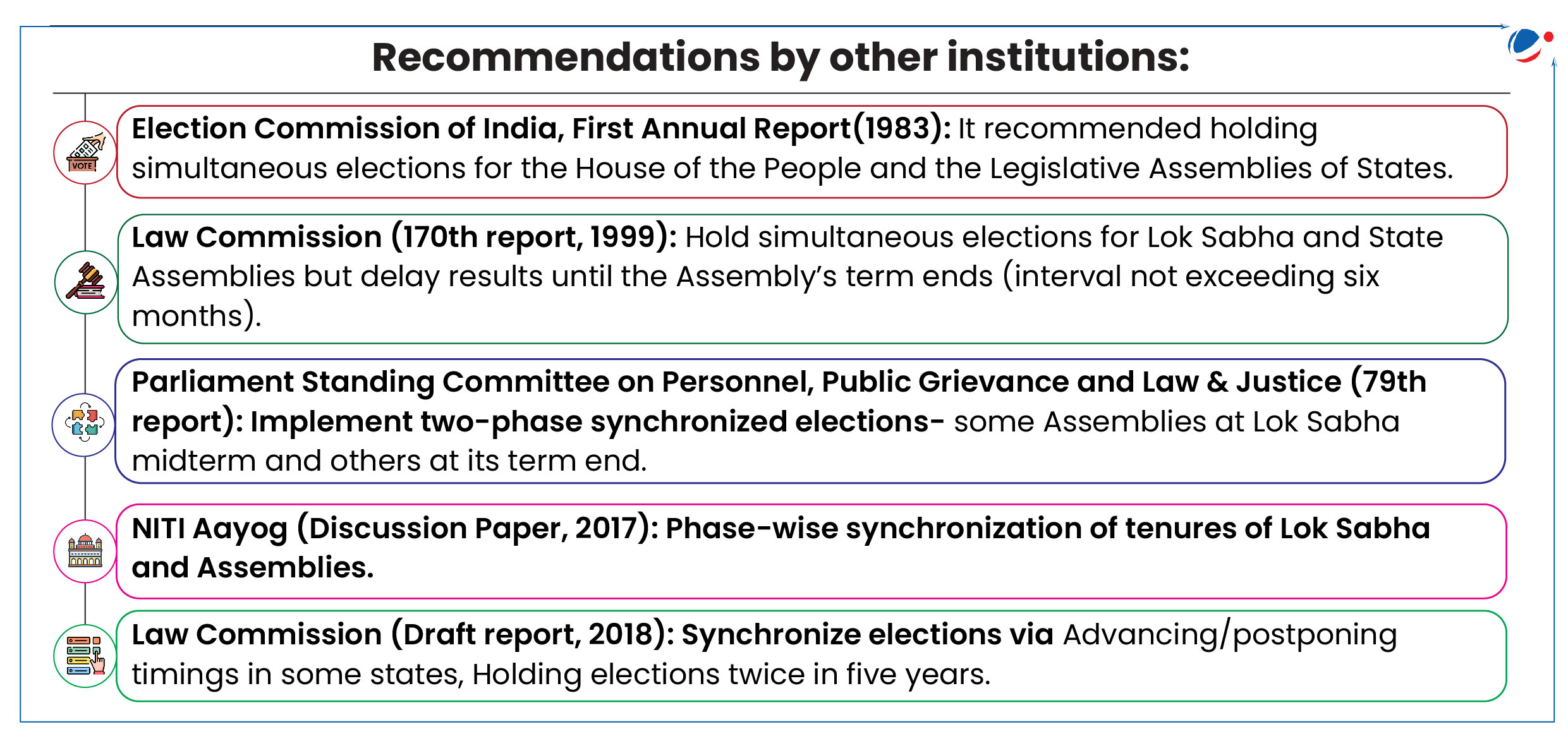Why in the news?
The Constitution (129th Amendment) Bill, 2024, and The Union Territories Laws (Amendment) Bill, 2024, introduced to give effect to "One Nation One Election" referred to the Joint Parliamentary Committee.
Key Provisions of the Bills
The Constitution (One Hundred and Twenty-Ninth Amendment) Bill, 2024 proposes amendments and new article to enable simultaneous elections for the Lok Sabha and State Legislative Assemblies.
Articles Amended | Article 82A inserted |
|
|
- The Union Territories Laws (Amendment) Bill, 2024: It proposes to amendment to the Government of Union Territories Act, 1963, Government of National Capital Territory of Delhi Act, 1991, and Jammu and Kashmir Reorganisation Act, 2019 to align the term of UT's Legislative Assembly with the Lok Sabha.
About Simultaneous Elections
- Simultaneous Elections (popularly known as One Nation, One Election) means holding elections to the House of the People, all the State Legislative Assemblies, and local bodies i.e., Municipalities and Panchayats, together
- Local bodies are not included in the bill.
- Simultaneous elections do not mean that voting across the country for all elections needs to happen on a single day.
- Previously, a high-level committee, headed by former President Shri Ram Nath Kovind, recommended a roadmap for holding simultaneous polls to Parliament, State Assemblies, and Local bodies.

Need for Simultaneous Elections:
- Financial Burden: Conducting simultaneous elections could significantly cut down the financial costs associated with multiple election cycles.
- This model reduces the expenditure related to the deployment of resources like manpower, equipment, and security for each individual election.
- Economic Impact: Asynchronous elections cause uncertainty and instability, thwarting supply chains, business investments and economic growth.
- Disruption to Governance and policy paralysis: Frequent imposition of the Model Code of Conduct (MCC) causes policy paralysis and slows down the pace of the developmental programmes.
- Voter Participation Challenges: Staggered elections induce 'voters' fatigue' and present a significant challenge in ensuring their participation.
- Operational Efficiency and Resource Optimization: Simultaneous elections would reduce the number of election-related offences and disputes and lessen the burden on courts.
Issues Involved in Simultaneous Elections
- Constitutional Challenges: Imposing of President's Rule could be misused to maintain synchronization.
- Logistical Challenges: India's vast electorate of over 96 crore electors (2024) requires over one million polling booths and significant security resources.
- Conducting simultaneous elections could strain administrative capacity.
- Concerns Regarding Federalism: Constitutional Amendments concerning the term of the state legislative assemblies under Article 172 can be carried out without ratification by states.
- Thus, opinion and say of States is reduced.
- Impact on Voter Behavior: Simultaneous elections may lead to a "nationalization" of local issues, with voters prioritizing national parties over regional concerns, weakening the voice of smaller parties.
- Legal and Parliamentary Requirements: Amendments to multiple constitutional provisions (e.g., Articles 83, 172, 327) and changes to the Representation of the People Act, 1951 are required.
- Political accountability: Frequent elections hold lawmakers accountable, while fixed terms may provide unwarranted stability without performance scrutiny challenging democratic principles.
Conclusion
Simultaneous Elections presents both potential benefits and challenges. While it could enhance political stability, reduce election-related expenses, and improve governance, concerns remain regarding logistical feasibility, potential for political manipulation, and the impact on smaller parties and regional considerations. Careful planning and a robust democratic framework are crucial for successful implementation.



